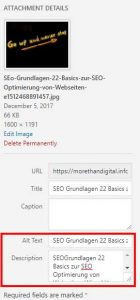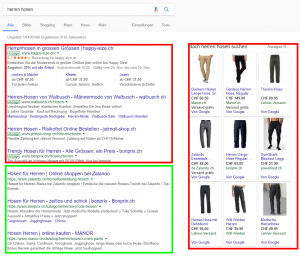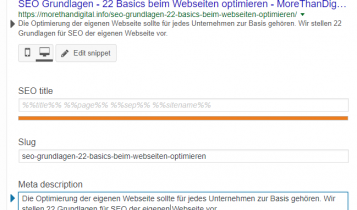SEO basics – 22 basics for website optimisation
Optimising websites with the help of SEO doesn't have to be difficult, we give you the basics
Every company should be aware that their website is the central contact point for customers. That is why easy discoverability also plays a role and for this purpose, one should understand the basics of search engine optimisation, abbreviated SEO, even as an entrepreneur.
We will guide you through the basics of search engine optimisation, or SEO for short. The aim is to optimise websites so that they can be found more easily by Google, Bing & Co. Especially for companies, this is an important process, as the website is a central contact point for customers and is becoming increasingly important.
Index
What is SEO?
As already mentioned above, it is about easier findability. This involves optimising the content as well as the technology of the site so that it appears as high as possible on the SERPs (search engine results pages).
There are 2 approaches to this, one is what can be optimised on one’s own website, this is called On-Page SEO. Off-page SEO is then something you do externally to push your website, something like link building, social media linking etc.
The aim of the article here is to improve the organic search results, so here is a quick graphic of which search results are ads, shopping or organic. Organic, and that’s what we need the SEO for, we can therefore slide up in the green. The rest of the content found in our search for “herren hosen” is all from Google Shopping (right) and ads placed in Google (top left).
Why do you need SEO?
Good page structure, simple layout, clear navigation paths and interesting content. These are all good prerequisites for Google & Co to easily find and search a website. Above all, the user experience, i.e. how well a page is designed for the user, has a great influence on indexability by search engines.
Especially if you want to attract additional customers and use the website as a sales channel, you come into contact with SEO at the latest then, because various studies have shown that most clicks come from the first search results. Therefore, it is particularly important for companies to be in the list of the first 3-4 results in order to gain customers in the long term.

What do search engines actually look for?
If you want to be found, you first need to understand what exactly they are looking for. In general, there are dozens and hundreds of factors in how search engines compile and present their results to us. We will probably never know how something is weighted or what the individual factor is. But some factors are fundamental and should be understood.
1. Relevance
Basically, it is important to understand that all search engines always look for the greatest relevance. Search results are selected to best match the customer’s search queries. So Google will try to give answers to questions like “How old is Arnold Schwarzenegger?” or even show search results that match when you type in “men’s trousers”.
2. Quality of content
Since Google also judges the quality of content, it is very important to understand that content should have added value, contain as few errors as possible, be easy to read, have longer and more precise content, as well as many other topics.
In short, it can also be said that SEO is very much related to content marketing, as only relevant content is also rated well by search engines.
Useful to know: 9 Content Marketing Tips for Small Businesses
3. User experience
Google’s latest search engine update also has artificial intelligence built in. This learns how users behave, what users click on, how they interact and what content is well received. Therefore, it is also important to build the website in such a way that the structure is simple, users can navigate quickly and that there are no errors in the website. So in short, you should give the user a good experience when they browse the website.
4. Loading speeds / page speed
An increasingly important ranking factor is the speed of the website. Studies show that long loading times lead to user abandonment and this also penalises Google. So you should use technologies like AMP and also optimise your website technology and hosting for a good user experience.
5. Security & SSL certificates
Search engines have also become more choosy about which websites they recommend to users. Since secure connections over SSL are preferred, websites are also ranked higher if they have at least SSL installed or even use HSTS headers. This can be seen when https:// is displayed and the “Secure” symbol is shown. It is therefore advisable to offer secure connections for your own SEO. Helpful article: SEO Basics – What is HTTPS?
6. Responsive / Cross-device compatibility
Already more than 50% of search queries are made via mobile phones. Therefore, it has become important for Google whether websites are displayed equally well on smartphones, tablets and computers. Thus, websites are also penalised if they are not optimised for mobile devices.
7. Internal linking
Internal linking is not only to help users see more content, but also to be found better for certain terms or to help Google. So the 3 elements that Internal Linking must fulfil are:
- Provide opportunities to find more content
- Rank for keywords (if you set the link text relevant)
- Help Google to crawl the page better
8. Authority / page authority
Page authority is an indicator of how much users trust the website. The industry, the linking from/to other websites as well as the quality of the content plays a role. MOZ, Semrush, Ahrefs all offer a tool for measuring and indicating this value, which can be used free of charge.
9. Meta Descriptions and Title Tags
Although a good meta description has no influence on search engine rankings, you should define it anyway. This is because users read these texts, which ultimately leads to them possibly clicking on your links.
Title tags are very controversial whether they are still used at all, we mention it because it is often asked. Generally, it was meant to be used to store terms for which the content should be found. As we said, title tags are actually no longer relevant and so you can save yourself the work.
Here is the example from this post, for example, we only store meta description and adjust the SEO title if necessary if something doesn’t fit exactly (we use Yoast for WordPress):
10. Schema markups
Schema markups can make your own content appear more beautifully in search results. Through these markups, content can be provided with more information such as customer ratings, images and other helpful information.
11. Images with correct Alt Text – Alternative Text

Images are an important component of content. Unfortunately, many forget to add the alt attribute, i.e. the alternative text. At the moment, Google cannot really “see” the images on the website, so you have to describe them for Google. In order to be listed in Google search for the images as well, you should therefore definitely fill in the alternative text. On the right, we have therefore shown the example from this post.
12. Domain names and structure
To make it easier for search engines, but also for more logic in user navigation, it is recommended to use sub-directory root domains (e.g. morethandigital.info/knowledge/faq) instead of sub-domain structures (e.g. faq.knowledge.morethandigital.info).
In general, it is not necessarily helpful to have a domain for a specific keyword if the content is of poor quality. However, if you have good content and relevant keywords, then a domain with the keyword can be helpful.
13. Headlines and permalinks
For optimal visibility in the SERPs, it is recommended not to use titles longer than 55 characters. It is especially important to have a good title that is as short as possible, has as much meaning as possible and contains keywords that are important.
The permalinks, links to the individual contents that are always named the same, are normally set by the CMS systems themselves based on the title. However, Google itself recommends adapting these links and mentioning 3-4 relevant keywords if the automatic link does not reflect this.
14. Comments
If you have a community and also share content where users would comment, then it is recommended to activate the comment function. If there is little or no interaction, it is better to disable this function.
If comments are possible, you should be very careful to set nofollow links for the comment section and also filter out spam as quickly as possible.
15. Local SEO – Google My Business
Google also tries to display search results according to their spatial relevance. This way, you are more likely to see content from your surroundings than content from far away. It is also advisable to make a local business directory entry in Google My Business and fill in the information there as well as possible.
16. Social media
One of the most effective methods for more reach and better distribution of content is, of course, the social media world.
We recommend opening channels that are relevant for your company and being present there. Interaction with your followers and your community is part of this and is becoming increasingly important for search engines.
What do search engines NOT want?
Of course, we also have to talk about topics that work against SEO. Especially in recent years, many myths and false truths have spread.
17. Keyword stuffing
Many have seen it as a challenge to get as many keywords into texts as possible. However, Google has started to penalise so-called “keyword stuffing” if it affects the readability of content.
18. Buying and exchanging links
Through many dubious methods, companies want to buy backlinks and register on various platforms in order to get a link there. However, this is not advisable, as only links of a certain quality count and if Google notices that you are buying or manipulating the links, you will be penalised. It is better to link to your suppliers and customers or write content that is willingly shared.
19. Annoying advertisements and overlays
If websites have a lot of pop-ups, overlays, extensive advertising compared to relevant content, then the chances of getting a Google penalty are very high.
20. Mobile app ads
If your mobile website has full screen ads, Google will see this as a sign that the website is not mobile friendly and will penalise the site accordingly in the search results on mobile devices.
21. Duplicate content – don’t just copy it!
When searching the content, Google finds out whether this text has already existed before and whether it has simply been copied. It is possible that you will be penalised or that the content will only be included in the index once. Of course, it can also happen that a stronger website copies the content and your own text is no longer indexed because the other site is more relevant. Therefore, be careful and publish your own content.
22. Hidden texts and links
There have always been “SEO specialists” who have inserted white text to hide dozens of keywords and links so that you have more keywords and links. Google can detect these tricks and penalises these actions.
Conclusion on the SEO basics
In general, it is important to work in a very customer-friendly way. If the website is cleanly constructed, offers content that helps the users and is also linked in such a way that it is easy to get information, then search engines will also index the pages. One should also pay attention to the clean linking, depositing of images and also the writing of relevant content and already one can improve one’s own web presence and be found by more customers.
In the coming months and years, Google will use its artificial intelligence to better determine which content is helpful and which is simply pointless. Therefore, it is advisable to deal more intensively with content marketing and to avoid basic SEO mistakes.




Comments are closed.